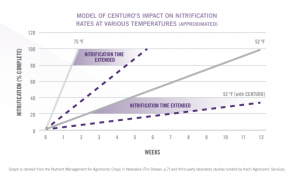If the historically late planting dates this spring have taught us anything, it’s that things don’t always go according to plan. But that doesn’t mean looking ahead is a fruitless practice. With that in mind, have you started thinking about your 2020 nitrogen plan? A strategically applied fall anhydrous ammonia can deliver significant agronomic and operational benefits come spring. But how can you be confident your nutrient investment will still be available when crops need it next year?
While there’s no way to guarantee anything when it comes to farming, there are actions you can take to set yourself up for success. As you begin to make plans for this year’s fall nitrogen applications, consider the best-practice recommendations of a fellow grower. Tim Laatsch is the technical agronomy manager for Koch Agronomic Services (KAS), and he knows this region since he’s been farming in Illinois for the past 20 years.
“Growers know it’s important to follow the 4R nutrient stewardship practices to prevent nutrient losses, because minimizing the potential for nutrient losses allows us to more sustainably manage our agriculture production systems,” said Laatsch.
According to Laatsch, keep these three things in mind:
- Apply nitrogen and inhibitors at the right time to protect your fertilizer until the crop needs it. To keep applied nitrogen in the ammonium form longer and minimize loss, wait to apply fall anhydrous until the 4-inch soil temperature has fallen below 50 degrees F.
- Always use a nitrification inhibitor, such as CENTURO™ nitrogen stabilizer, with fall-applied anhydrous to slow the conversion of ammonium and minimize nitrogen leaching beyond the root zone.
- Developing a split-application plan can help reduce your overall risk of nitrogen loss and ensures that nitrogen is available to the plant during the maximum uptake period of rapid vegetative growth.
“There are countless split-application combinations, but a more common practice is to apply roughly two-thirds of your nitrogen needs in the fall as anhydrous and then side-dress the final one-third in the spring as UAN or urea,” he said. “With such a large portion of nitrogen being applied in the fall, it is critical to protect your anhydrous with CENTURO so it will be available when the crop needs it in the spring prior to your second pass of nitrogen.”
What happens to nitrogen between fall and spring?
In ideal soil and weather conditions, properly applied fall nitrogen will remain inactive in soil through the winter until warmer temperatures activate the nitrification process, distributing nutrients to spring crops at the right time. But unless you’re in the frozen tundra, most climates fluctuate with occasional warm winter days. Mix that with varying soil pH and moisture levels and you’ve got an unpredictable landscape, where your nitrogen investment can be highly susceptible to denitrification and leaching if left unprotected.
CENTURO is the first nitrification inhibitor for anhydrous ammonia and UAN to be registered by the EPA in more than 40 years. The patented active ingredient in CENTURO, Pronitridine, slows the nitrification process. So, when Mother Nature does her best to disrupt your best laid plans, you can be confident your nutrients are protected. CENTURO has been proven to extend the window of protection for anhydrous ammonia three times longer than without a nitrification inhibitor.1

When it comes to farming, the only certainty is that every season comes with unpredictable risks. Some of the best decisions you can make for your operation next year take place this year. If a fertilizer application window opens up this fall, keep the above best practices in mind and ask your fertilizer dealer about extending the protection of your nitrogen investment with CENTURO. Learn more about CENTURO here or contact your KAS sales rep to find your local retailer.
1The underlying data is based on third-party laboratory studies funded by Koch Agronomic Services; results may vary based on a number of factors, including environmental conditions. Improvements in nutrient use efficiency, yield and nitrate leaching may not be observed in all cases. CENTURO™ and the CENTURO logo are trademarks of Koch Agronomic Services, LLC. Koch and the Koch logo are trademarks of Koch Industries, Inc. © 2019 Koch Agronomic Services, LLC.
Paid for by Koch Agronomic Services.


